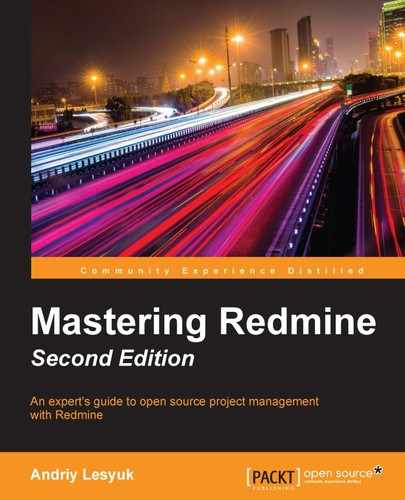Considering the fact that time tracking functionality is provided by a project module, why didn't we review it along with other modules in Chapter 5, Managing Projects? Other project modules do not provide enough functionality to make users install Redmine for them, or they just have a much better competitor (for example, MediaWiki or DocuWiki is much better than the Wiki module, Invision Power Board or phpBB is better than the Forums module, and so on). On the contrary, the Time tracking module is complete and competitive (considering the functionality that is provided by the Redmine core and its other project modules,), and often enough it becomes one of the main reasons for using Redmine. Thus, I first used Redmine as a time tracking application.
But why is this chapter so late in the book? Despite its functionality, time tracking cannot be considered a primary feature of Redmine. Moreover, in practice, it is disabled in the majority of Redmine installations. In other words, it's less important to know than the functionalities that were reviewed in previous chapters. Therefore, this is also the first (and the only) chapter that you don't need to master (if you don't plan to use time tracking, of course). If, however, you decide to continue reading it, you will learn how to submit your time entries, how to generate time reports and what third-party tools you can use to improve your time tracking experience. Certainly, in this chapter, we will also mention some other functionality, especially issue tracking, as time tracking is generally based on issues.
So, in this chapter, we will cover the following topics:
- Time tracking in Redmine
- Activities
- Tracking your time
- Checking out the spent time
- Time reports
Why should Redmine be chosen over other time tracking alternatives? The answer is, because of the inclusion of other features (not only issue tracking). Generally, time tracking applications rarely come alone, as this is a simple task that is unlikely to have many features. Thus, it is available as an additional feature in Trac, OrangeHRM, and so on.
So, let's check out the benefits of time tracking with Redmine:
- In Redmine, time entries are associated with issues. And issues have a detailed description of what should be done. They can be shown on the Gantt chart, and much more.
- Issues can also have an estimated time. This time can be used to evaluate the speed of development, determine problematic tasks, and so on.
- Users can specify what they have been doing using the Comment field of the time entry.
- With the help of the Activity field, administrators and project managers can categorize time entries.
- Redmine allows users to add time entries through SCM commit messages (we'll discuss how to do this in detail later).
- A report on the spent time is available.
- Whether it's a benefit or not, Redmine supports only the hour value (which can be a float though) and does not care about the start and end times.
In order to be able to use the Time tracking module in the project, make sure that the Time tracking checkbox is checked under the Modules tab of the project's Settings page.
Also, to enable the Time tracking module for all new projects by default, do the same under the Projects tab of the Settings page in the Administration menu.
